Listed: Brisbane’s top dog trainers, their tips, pet peeves and what they’ll cost
A Covid pandemic-related pet boom has kept dog trainers busier than ever so we talked to six of southeast Queensland’s top experts to get their tips, common mistakes by owners and what training should cost.
Pets and Wildlife
Don't miss out on the headlines from Pets and Wildlife. Followed categories will be added to My News.
From being asked to teach a dog to use a human toilet to how to train a snake, some of southeast Queensland’s most popular dog trainers already had their work cut out for them.
With pet ownership at record levels following the Covid-19 pandemic many dog trainers say they are busier than ever and are pushing for the industry to become regulated in Australia, meaning it would be a requirement for all trainers to obtain qualifications through accredited programs.
Several area trainers also agree the pandemic and resulting lockdowns has led to an increase in pets experiencing separation anxiety and reactive issues, or dogs colloquially dubbed “Covid puppies.”
A 2021 Pets and the Pandemic report by Animal Medicines Australia found there were now about 30.4 million pets in Australian households.
The study found the proportion of pet-owning households increased from 61 per cent to 69 per cent in a little more than two years, with one in four cats and one in five dogs becoming part of the family during the pandemic.
The pet boom has led to the increase in work for dog trainers as well as put pressure on the veterinary industry, with professionals from both fields recommending dog owners do their research.
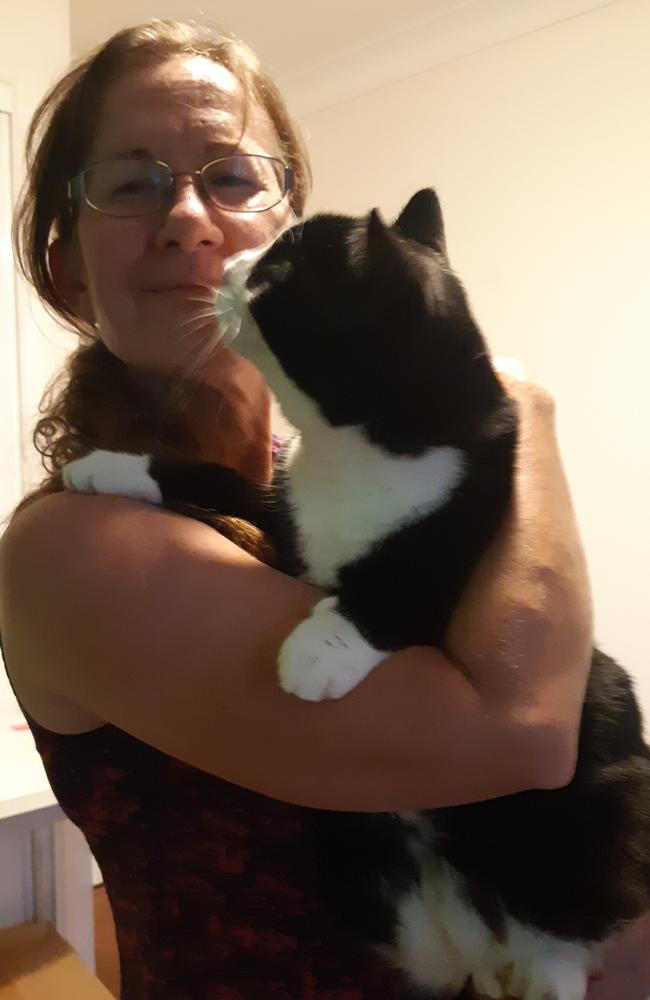
Behaviour veterinarian Rimini Quinn, 49, of Beerwah said she often refers people to trainers and vice versa, depending on a dog’s issue.
The Kind Animal Behaviour Services Veterinary Clinic owner said the best trainers do not follow long-debunked training styles, but are educated with the most up-to-date, science-based training methods.
“I tell people to use only 100 per cent positive reinforcement trainers and professional trainers, which means they’ve done a certificate or some type of training education, because you want someone that understands learning science, and how animals learn,” she said.
“There’s lots of science behind (modern dog training), that shows us positive reinforcement training works best, gives the best results and does not harm the dog.”
Dr Quinn said research was important because the dog training industry was unregulated.
“Anyone can put up a little sign saying they’re a specialist,” she said.
“I know that some of the training bodies in Australia would like that to change and they’re working towards that, which would help.”
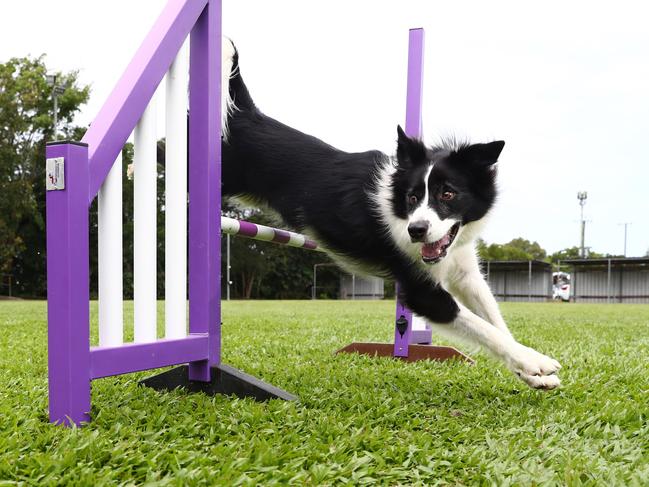
Besides asking for certifications – such as from the Delta Institute, the accredited body for positive reinforcement trainers in Australia or similar internationally accredited organisations – Dr Quinn said owners should ask questions and listen for potential “red flags” in the answers when seeking a professional trainer.
“You could ask ‘If my dog does the wrong thing, what would you suggest that you do?’” she said.
“If the answer suggests any force or form of punishment, then that would be a red flag, as is using any equipment which is aversive, things like prong collars or harnesses which pull in tight. People don’t realise sometimes these types of things might be painful … and cause long term psychological harm in the future.
“Dogs can make a connection between having something painful happen to them, such as a jerk or a tightening of a lead at the same time they see another dog, for example, and that can just add negative feelings towards other dogs.”
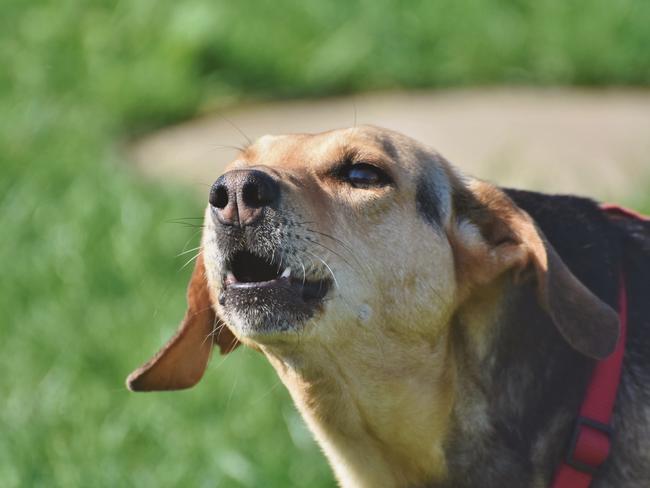
Instead of eliminating the issue, the association instead often just led to an increased level of reactivity because the dog experiencing the pain might think it was caused by the other dog, she said.
Dr Quinn said some people still believed the outdated methods worked, despite decades of research having proven them ineffective in the long term.
“Unfortunately, (the negative methods) can stop a dog’s behaviour temporarily, just in that moment, so it can seem like it’s worked,” she said.
“But because all the emotion is still there, the problem is actually still there and usually (the behaviour) will push through even stronger than it was before.
“There still does seem to be a lot of lingering “traditional” training, where it says you have to be the boss, to dominate your dog or use choker collars, all of which were proven to be incorrect many decades ago.
“We want them to be able to learn things from their training and improve things and we should do no harm. Some of those outdated techniques can do harm.”
The behaviour vet also recommended dog owners check the Pet Professional Guild of Australia (PPGA)’s web site to find some qualified, positive reinforcement, force free trainers in each state.
The Courier Mail spoke to six of the greater Brisbane area’s top go-to trainers and asked them everything from why they became trainers to their observations following the Covid-19 pandemic, the most common mistakes owners make with their dog, as well as for some of their top training tips.
The six trainers all said the most common issues they have been seeing since the pandemic is an increase in dogs with separation anxiety or reactive issues as a result of long lockdowns.
ANNE HARDACRE, PAWSITIVE CONNECTION
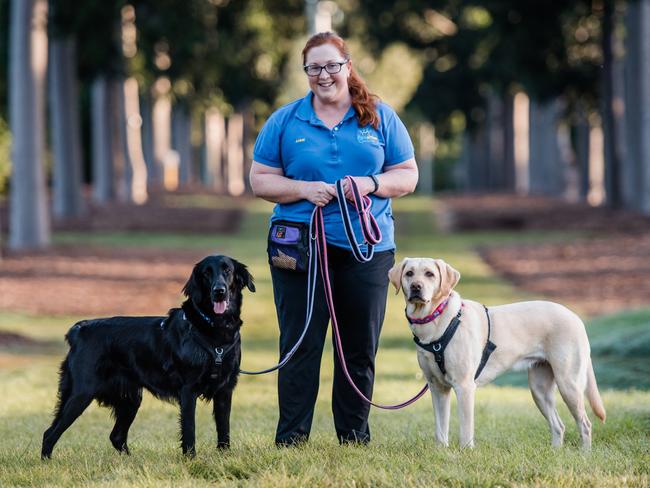
Anne Hardacre, 47, of Walloon, is one of four certified professional dog trainers with Pawsitive Connection, along with Nicola Westerweel, Rosalynd Taber and Rachael Haines.
Ms Hardacre, who also holds a certificate in small animal nutrition, decided to become a professional dog trainer after completing classes with her Labrador, Molly, and her cattle dog Labrador cross, Merlin, at Brisbane’s RSPCA, then in Fairfield, in the late 1990s.
“I started training my own dogs in 1998 or 1999 and just got hooked on dog training classes and having fun,” she said.
The then-University of Queensland animal technician and facilities manager enjoyed playing agility with her dogs in her free time so was excited when an opportunity to become a dog trainer through the RSPCA presented itself in 2003.
The women all left the RSPCA and started Pawsitive Connection in 2013, adding to their qualifications through the international Certification Council for Professional Dog Trainers and through Fear Free Pets, a Veterinary Professional Certification Program, among several other professional courses.
Ms Hardacre said the Covid-19 pandemic had resulted in an increase in separation distress and dog reactivity behaviours.
Dubbed “Covid puppies”, Ms Hardacre said a lot of people got a new puppy, but that dog then missed out on crucial socialisation at a young age due to the pandemic lockdowns.
“Dog ownership has increased exponentially,” she said.
“With that, there comes the issues. When Covid started you could not go out, including to dog training classes.
“A lot of people worked from home, but when they went back to work they found there were a lot of separation distress issues with their dog.”
Q and A:
What are your top tips for dog training?
Play with your dog, have fun and be consistent
What is your pet peeve?
When people call out to you when walking your dog “who’s walking who?” thinking it’s funny but actually shows a misunderstanding of who the walk is benefiting.
Also when people don’t do puppy class because “they have done it before with other puppies”.
Puppy class is so important for early learning and socialisation around other people and dogs. If people choose not to do it because they have done one with another puppy, unfortunately means their puppy misses out on valuable learning.
What are the most common mistakes owners make?
Probably going too far too fast when training and not breaking it down into smaller steps for the dog. Then, not teaching the dog those steps in different environments, but expecting the dog to know what is expected.
Cost: What should you realistically expect to pay a professional dog trainer if private lessons are chosen over group ones?
(A dog trainer’s fees) should reflect the amount of time, study and learning each and every one of us has put into their careers. It can cost because it took a lot of time to learn and to be an accredited dog trainer. Like any specialist in their field, fees reflect that.
Group classes of about six weeks in duration can vary from between $200 to $300, while some private sessions can vary from about $200-$300. Fees can include the planning and preparation that goes into the service plus the travel (petrol and car maintenance).
What should you consider before getting a dog?
Time you have to put into being with the dog and training it, what your lifestyle is like (active, sports, or quiet), family life (kids, holiday plans etc).
What does it take to be a great trainer?
I think empathy, listening skills and ability to communicate well with people. Also, the ability to think on your feet and change things so it works for the individual dog you’re working with and sets them up for success.
What has changed since the Covid-19 pandemic?
More people have dogs. Dogs are also needing to cope with changes in routine such as people working from home a lot more.
What was your most unusual client request?
It’s probably not an unusual request but maybe a more frustrating one. It’s when clients expect to know how long it will take to ‘fix’ their dog. It’s not about ‘fixing’ the dog, but behaviour change done right takes time and consistency. There are a lot of factors involved, a major one is client compliance. Explaining how dogs learn and then how to change behaviour can teach clients that we don’t have a magic wand, but that it takes time and effort for lasting behaviour change.
What should you look for in a trainer?
Someone who is qualified and up to date with modern science based training methods and a member of organisations whose ethos is to use positive, fear free methods.
DEJANA ‘DE’ DURDEVIC - SIT, STAY, PLAY

Before becoming a qualified dog trainer, Dejana ‘De’ Durdevic, 33, of Moorooka, worked at a pet shop while studying for a Bachelor’s degree in wildlife science and separate graduate diplomas in psychology and animal biosecurity.
“Dog training was always an interest of mine in uni, and doing the behaviour entity of the degree struck my fancy,” she said.
The owner of Sit, Stay, Play Qld became certified through the Delta Institute, the accredited body for positive reinforcement trainers in Australia, in 2011.
“I first started the business as an in-home pet sitting service to get out of mum and dad’s house, while I was still in uni,” she said.
As a trainer, Miss Durdevic said she most enjoys advocating for dogs and teaching people about how to read canine body language.
“It’s advocating for the dogs, we don’t give them enough consent,” she said.
“Advocating for the dogs and educating the people, bringing awareness for why and how we’re advocating, while always working from a force free, fear free perspective.”
Miss Durdevic said she recommends people seek out certified dog trainers because anyone could claim to be a dog trainer.
“It’s an unregulated industry in Australia, so anyone can just wake up and say ‘I want to be a dog trainer today’, start advertising, and teach on YouTube,” she said.
It was also so dog owners know a trainer follows modern practices, as outdated methods, such as the belief the human had to be the ‘alpha’ in the family, have not been recommended for decades.
“Dog training in itself is a science based field. We’re not training at a point we were 60 years back,” she said.
“We should be, in 2022, listening to the research that’s out there.”
Q and A:
What are your top tips for dog training?
The 3 C’s, to be: Consistent, Calm, Clear
What is your pet peeve?
When people think that a dog feels ‘sorry’ for doing something ‘naughty’ but in actual fact the dog is exhibiting appeasing behaviours because your body language is stern and angry. They are just responding to your body language, they do not know what they did wrong.
What is the most common mistake owners make?
They continue to follow a dog that is pulling on lead, and then wonder why their dog pulls on the lead (think about it).
Cost: What should you realistically expect to pay a professional dog trainer if private lessons are chosen over group ones?
A private one-on-one dog training session can vary depending on the issue. Prices could be anywhere from $80 to 300 for an hour.
What should you consider before getting a dog?
Do you have enough time and effort to put into a new puppy/dog NOW, and for the next 10-20 years? It’s a full time job just, like human parenthood.
What does it take to be a great trainer?
Lots of education, handling experience, training experience, meeting new people and dogs, time.
What has changed since the Covid-19 pandemic?
There are a lot of dogs around now, and most of them have separation distress.
The poor things have been home with the ‘pawrents’ for a year and now the ‘pawrent’ needs to go back to work in the office. The result is the dog is now stressed without the human at home.
What was your most unusual client request?
How to teach cool tricks – I hardly EVER get this request, and the other day I did, with a Papillion puppy called Bear at Newstead.
What should you look for in a trainer?
Qualifications, their morals (towards dogs and their existence in our lives) and ethics (how they treat the dog in the sessions, fear and force free style training).
JODIE WESTFIELD, INSYNC PET SERVICES
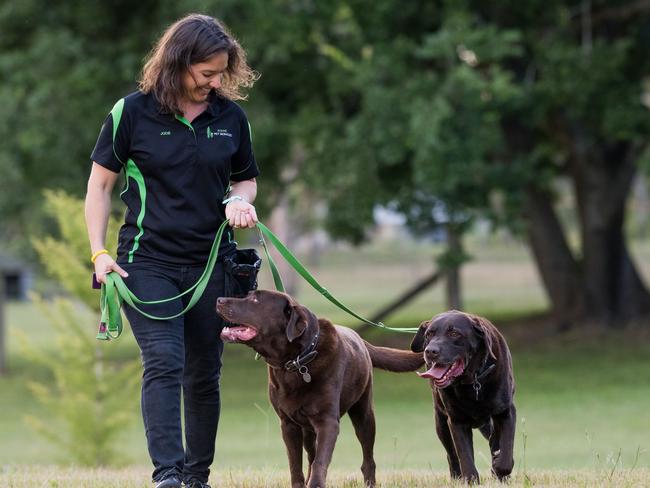
Jodie Westfield, 47, of Upper Kedron started her business Insync Pet Services four years ago after leaving her job as an executive assistant in the construction industry.
The former professional inline skater said she completed a Delta Institute course when her daughter turned one.
“I needed to go back to work or do something and started studying dog training,” she said.
“I had a one and a three year old and … wanted to be my own boss.”
Besides shadowing other dog trainers, Mrs Westfield also put her practical skills into practice at the Animal Welfare League’s Bracken Ridge shelter, where she had been volunteering for about 18 months.
“Because I was doing Delta, I was allowed to work with the more difficult dogs and so built a lot of my skills there,” she said.
Mrs Westfield said she became interested in dog training thanks to her first dog, Darcy the chocolate Labrador.
She said Darcy, who they got at 2-years-old, was under socialised and reactive on lead, which only seemed to worsen as he grew older.
“Then he struggled with our oldest child. When he started crawling Darcy would growl at him,” Mrs Westfield said.
After seeking professional help, it was discovered Darcy had anxiety issues, which has led to the trainer’s passion of helping dogs that are reactive or anxious.
Mrs Westfield, who also has several other certifications, said she is also an approved mental health assistance dog trainer for mindDog.
“I just love helping people help their dog,” she said.
“I love seeing the relationship grow, I love building the relationship. I like seeing the light bulb moment with the dog and the person.”
Q and A:
What are your top tips for dog training?
It’s really important to give your dog clear and consistent instructions and boundaries.
Incorporate several short daily training sessions with your dog and reward the behaviours you like to see. When you have a puppy, don’t expect too much too soon, they are babies, have fun with them, but also know they will bite, toilet inside and chew things.
Watch, learn and listen, they communicate to us through their body language.
Get help earlier rather than later, don’t wait for a behaviour to become unmanageable before seeking out the help of a qualified trainer.
What is your pet peeve?
One of my pet peeve’s with the industry is the lack of regulation, basically anyone can call themselves a dog trainer. There is so much information available to people online and it can be confusing and difficult to navigate.
Owners asking me for a specific time frame. There are so many factors that influence the individuals learning, the issues they have, how long it has been practised, and if there is there any fear or anxiety associated with the issue.
What are the most common mistakes owners make?
Often owners underestimate how much time it takes to train a dog, especially a puppy.
It is really important to not only have early training or attend a good puppy class, but to also continue the training as they come into adolescence and then into maturity.
Owners will often turn to Google for advice and are often left confused about what the best way to solve an issue.
They don’t reward them enough, over time this does reduce but if you are generous when teaching them and you will be rewarded with a dog or puppy that learns quickly.
Cost: What should you realistically expect to pay a professional dog trainer?
There are many factors to consider when looking at costs and they vary a lot. Group classes are great for socialisation, but this option doesn’t suit everyone. Another great option is one-on-one training. My group classes start at $200 for five weeks or $240 for six weeks.
Private training prices vary depending on various factors and average between $120 to $475, depending on those variables.
What should you consider before getting a dog?
There are so many things to consider when getting a dog and the questions you ask yourself include: Do you want a puppy or an older dog? How much time do you realistically have to spend with your dog? What activities would you like to do with your dog?
Can you afford the ongoing costs of a dog (food, working, vet bills, insurance, equipment and training?).
What does it take to be a great trainer?
To be a great trainer you need to be able to relate and communicate to humans as much as the dogs. I spend a lot of my time training people to train their dogs.
Having a great understanding of dog body language and knowing what to look for as our dogs communicate with us all the time and we need to learn their language.
It’s also really important to keep up to date with the latest scientific methods, attend conferences, and to continue learning by completing relevant courses.
What has changed since the Covid-19 pandemic?
A lot of people spend much more time with their dogs which is lovely, but on the negative side a lot of dogs missed out on some key socialisation which is coming through now.
There were also some issues around dogs not being confident at being alone.
A great option now available for many trainers is Zoom. This was very rarely an option prior to Covid and it has provided access to trainers for people who live in remote areas.
It has also provided an opportunity for trainers to access clients in areas much further afield and cover areas that they can’t travel to. It’s also a great option for bad weather or for dogs that don’t like strangers.
What was your most unusual client request?
Someone asked me to train their dog to bark at strangers. They said their dog was too quiet, but only wanted it to bark at strangers and nothing else.
What should you look for in a trainer?
When looking for a trainer, look for qualifications and if have they continued their education after graduation. Check to see if they have any memberships, such as with the Professional Pet Guild (PPGA) or Delta as they are very specific about the methods their members use.
Research what methods the trainers use. Some key words to look for are ‘rewards based’, ‘force free’ and ‘positive reinforcement’.
Also, look at a trainer’s online reviews and see how many people recommend them.
JUSTIN JORDAN, JORDAN DOG TRAINING
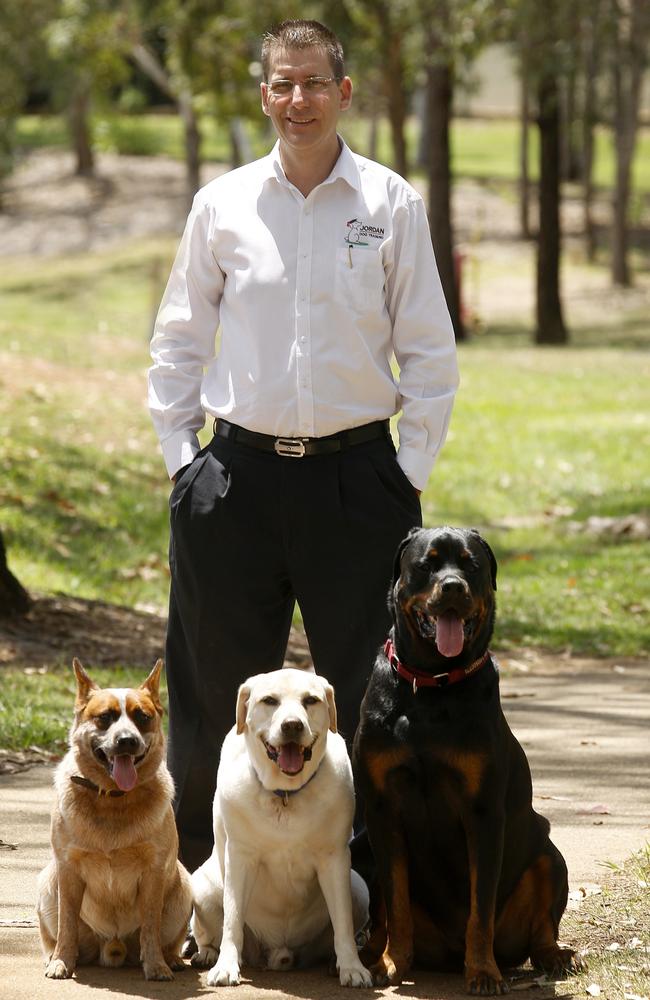
Justin Jordan, 53, of Albany Creek was 15 when he first started training dogs as a hobby.
He continued to volunteer at training organisations around Brisbane throughout his 16 years in a sales and marketing job.
“I’ve always been very passionate and trained dogs since I was a kid, my own dogs and other people’s dogs,” he said.
Eventually becoming tired of the corporate world, Mr Jordan bought the first Queensland franchise of Dog Tech International, founded by Australia’s “original dog whisperer” the late John Richardson, who took him under his wing.
A decade later, Mr Jordan started his own business, Jordan Dog Training.
While his experience is mostly from on-the-job training, Mr Jordan said he attends numerous seminars and keeps abreast of modern, gentle techniques.
He also prefers to employ trainers with qualifications, such as from the National Dog Trainers Federation.
One of Mr Jordan’s dogs, Red the Australian cattle dog, was the Queensland Reds rugby team’s junior mascot for several years, though the 8-year-old red heeler has now retired.
Mr Jordan said when he cringes at the now outdated training methods taught when he was a teenager.
“When I first started, we used check chains because that is what we were taught,” he said.
“Training back then, in a lot of cases, was a bit more boot camp, Sergeant major, paddock bashing training, but it’s definitely not the way we do things these days.”
Mr Jordan said some of the changes he had seen over the years included owners now including their dogs as part of their family.
“They’re treated more as an integral part of the family now, rather than just a dog outside,” he said.
Q and A:
What are your top tips for dog training?
Patience and understanding. All training should be short positive and fun sessions.
Every interaction with your dog is an opportunity to train your dog.
What is your pet peeve?
People that believe dogs don’t need to be walked or socialised.
What are the most common mistakes owners make?
Being inconsistent with their training methods and their expectations from their dog.
Also, not exercising them enough and giving them enough mental stimulation.
Cost: What should you realistically expect to pay a professional dog trainer?
Training shouldn’t be expensive, but it’s a tough one as it really depends on the dog, the issues and what we are trying to achieve. Tricks courses are $135 for a three-week course and four week puppy school courses are $155. Obedience courses are $275 for a lifetime membership so they can come back as many times a week as they like to any of our locations for the life of the dog, Home Consultations can be between $185 and $285.
What should you consider before getting a dog?
Have you got the time to spend with the dog?
They are a lifetime investment, for the life of the dog.
What will you do when you go on holidays?
Does your budget allow for potential medical costs if something goes wrong? Will the dog be allowed to be a full part of your life and allowed inside with and as part of the family?
What does it take to be a great trainer?
Love, passion, patience and understanding.
What has changed since the Covid-19 pandemic?
People have spent more time at home with their dogs so the dogs have got used to them being around the majority of a time.
As things are getting back to normal and people are getting back to work and getting back to their normal lives, some dogs are now not coping with being left alone for hours on end as the owners go back to work.
In some cases, this has resulted in destructive behaviour form the dog due to stress or boredom.
What was your most unusual client request?
To teach a five-month-old cavoodle how to use the human toilet by itself. It took a bit of patience, repetition and time.
What should you look for in a trainer?
Someone that is patient, that is happy to actually listen to you and understand your needs and your dog’s needs. Someone that is prepared to spend the time with you both to reach your goals using gentle and positive methods.
MADDIE ROSS, BEACON DOG TRAINING
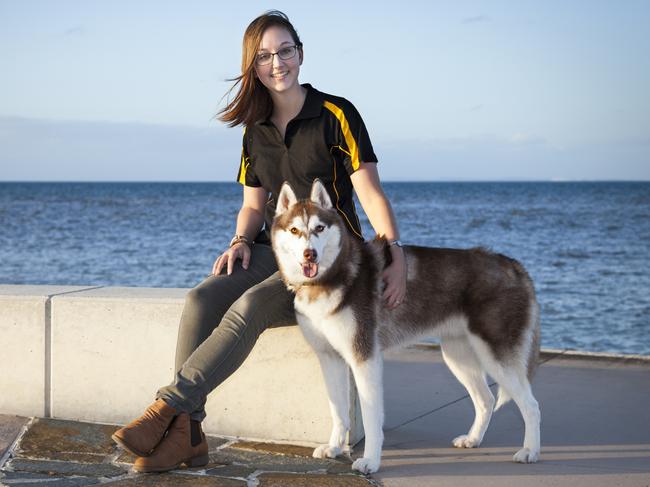
A passion for dog training was ignited for Maddie Ross, 31, of Burleigh Waters, her dog developed aggression issues.
“I first entered the world of dog training when one of my dogs, Toby, developed aggression issues at 12 months of age,” she said.
“The journey to rehabilitate Toby ignited my passion for dog training, and I first started as a professional trainer in the hope that I could help others in similar situations.”
Beacon Dog Training opened in 2017, with Mrs Ross as the head trainer.
She loves helping dogs and owners understand each other.
“I love how understanding the science behind dog behaviour opens a whole new world of communication between people and dogs,” she said.
A supporter of professional dog trainers being certified, Mrs Ross maintains her qualifications through the Certification Council for Professional Dog Trainers.
“I have my CPDT-KA certification (Certified Professional Dog Trainer-Knowledge Assessed) through the Certification Council for Professional Dog Trainers,” she said.
“Though certification isn’t required in Australia, I believe that our industry is lacking in this area and chose a certification recognised internationally.
“I love that they require ongoing education to remain certified, ensuring trainers keep up to date with their knowledge.”
The Gold Coast resident, who has a computer animation degree, said she also jokes that she is a human trainer.
“If you’re considering becoming a dog trainer who works with pet dogs, be sure that you also enjoy working with and teaching humans,” she said.
“I always joke that I’m as much a human trainer as I am a dog trainer, and I enjoy that part of my job immensely.”
Q and A:
What are your top tips for dog training?
Be proactive rather than reactive. Your training will be far more efficient and effective the more you plan ahead and set your dog up for success, rather than only attempting to train them in the moment they are doing a behaviour you dislike.
What is your pet peeve?
I struggle when I’m out and about and see people interacting with their dogs in ways that will make their problem worse; for example watching a stranger at a cafe yell at their dog for barking when the dog is barking out of fear.
A scared dog plus a scary owner makes the dog more fearful, and it’s difficult for me to ignore these situations.
What are the most common mistakes owners make?
Assigning inaccurate motives to their dog’s behaviour. We all love our dogs and it’s easy to assume they have human motivations for their behaviours, but doing so can lead to miscommunications and frustrations.
Understanding why dogs do things is the first step to successful training.
For example, if an owner comes home to find their dog has destroyed the couch cushions, and assumes the dog was motivated by spite, they are likely to attempt to punish the dog for the “bad behaviour” and view cowering and cringing as an admission of the dog’s guilt.
If the dog was in fact motivated by panic and anxiety at being left alone, then punishment will do nothing to address the actual issue, and may even make the situation worse.
Cost: What should you realistically expect to pay a professional dog trainer?
Sometimes a cheap trainer can be more expensive in the long run. Since our industry isn’t regulated there are many trainers without education or experience who offer quick fixes for little cost. Badly done training often complicates problems and makes it more difficult and costly to work through the issues properly. Group classes range from $185 to $275 and go for around six weeks, while one-on-one training averages about $250 per session. Behavioural issues like reactivity and anxiety are usually more expensive to address than regular manners training.
What should you consider before getting a dog?
I recommend people choose a type of dog that is likely to fit with their lifestyle and how much time they have for training, rather than choosing based on looks.
Talking to a trainer BEFORE you choose a type of dog is a fantastic idea, we love helping clients find a good match.
What does it take to be a great trainer?
Firstly people skills, not just dog skills. You can be the best trainer in the world but it does little good to your clients if you don’t also have excellent communication skills.
Second, an understanding of WHY various techniques work when training dogs.
Any trainer can copy what they’ve seen somebody else doing with a dog, but an understanding of dog cognition and behavioural science is necessary to be a truly great trainer.
This understanding of what is going on beneath the surface allows great trainers to adapt training strategies to fit a dog’s individual needs and circumstances.
What has changed since the Covid-19 pandemic?
We are seeing a greater number of dogs with separation related issues, and issues connected to lack of proper socialisation as puppies.
What was your most unusual client request?
It wasn’t my own client, but a trainer I know once had a client who requested their dog be trained to “chase off the ugly birds but leave the pretty ones alone.”
What should you look for in a trainer?
Someone who communicates well. Your trainer shouldn’t judge or belittle you for mistakes you may have made with your dog. Someone who takes both your needs and the dog’s needs and emotions into account. Someone who is committed to ongoing education and ensuring the methods they use are based on behavioural science.
TRISH ALLEN, ALL PETS EDUCATION AND TRAINING
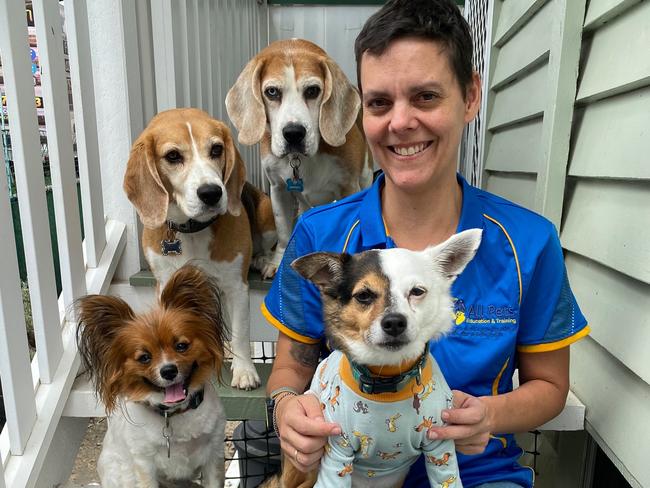
Originally a veterinary nurse, Trish Allen, 43, of Camp Hill has been a professional dog trainer for 10 years.
A Jill of all trades, she teaches animal science courses at TAFE and still works “occasionally” as a vet nurse, on top of her dog training work.
With qualifications through the Delta Institute and other international programs, Miss Allen is also in the process of completing a Holistic Diploma in Dog Behaviour and Animal Emotions course.
“I believe education is key for everything, and I will also be studying and learning until the day I die,” she said.
The All Pets Education and Training owner said she decided to become a professional dog trainer after working in the veterinary industry as well as owning her own “difficult” dog.
“I like helping build the person and animal relationship,” she said.
“A relationship based on communication and trust.”
Miss Allen said the only thing she did not like about dog training was how some owners did not want to put the time and effort into the training their dog needed.
“People sometimes want a quick fix and won’t put the time and effort in,” she said.
“The animals we are dealing with are sentient beings, and sometimes I feel others see them more as a commodity.”
Q and A:
What are your top tips for dog training?
Focus on what you want, rather than what you don’t want. Train and reinforce for what you want. Prevent rehearsal of undesired behaviours, and be prepared to modify your expectations. All dogs aren’t created equal, and training should be designed for an individual animal.
What is your pet peeve?
Owners: The expectations of miracles and magic wands.
Trainers: It is an unregulated industry. Anyone can call themselves a trainer and as a result many dogs are harmed by those with lack of skills.
What are the most common issues with dogs that you see?
I mostly see anxious and reactive dogs. I also specialise in cooperative care and husbandry – making vet and grooming experiences less stressful for everyone.
What are the most common mistake owners make?
Feeding from a bowl and not using the daily food allowance for enrichment and training purposes.
Cost: What should you realistically expect to pay a professional dog trainer?
Costs vary greatly. My costs are kept low. About $100 for zoom and about $145 plus travel for face-to-face sessions.
What should you consider before getting a dog?
Time, commitment, costs, breed and what was its original purpose, grooming.
What does it take to be a great trainer?
Empathy, communication, and human and animal relationship skills.
What has changed since the Covid-19 pandemic?
I’m busier than ever with zoom consults and group classes.
Many dogs were bought during Covid, so we are now working through a number of dogs with separation distress.
What was your most unusual client request?
To train their snake to move out of his enclosure for cleaning as he used to bite his people. We had to think outside the box for a reinforcer as food was not going to work. We used access to a tube with a substrate the snake preferred.
What should you look for in a trainer?
Someone with the same values and ethos as the other. Someone that has qualifications and that will communicate with you and provide support outside of scheduled appointments and classes (I use email, Facebook groups and Marco Polo).
A person that looks at the dog, humans and situation as individuals and will guide a plan for their specific needs.



